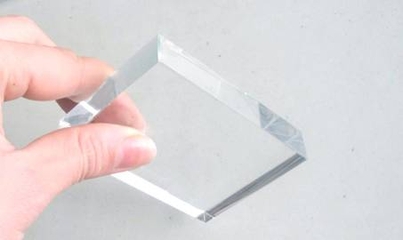Do You Know Ultra White Glass?
Click:
-Time:2022-04-27 14:10
Ultra white glass is a very energy-saving glass original, also known as high transparent glass. It is a new high-grade glass variety with high quality and multi-function, with a light transmittance of more than 91.5%. It has the characteristics of crystal clear, high-grade and elegant. It is known as the "crystal Prince" of the glass family. Ultra white glass has all the processability of high-quality float glass at the same time, and has superior physical, mechanical and optical properties. It can be processed like other high-quality float glass. Unparalleled superior quality and product performance make ultra white glass have broad application space and bright market prospects.


General glass contains certain ferrites, which will lead to different degrees of green visual effects. The content of ferrites in ultra white glass is 10% or even lower than that of ordinary glass, which has the appearance characteristics similar to colorless crystal.
What are the advantages of ultra white glass?
1. The self explosion rate of ultra white glass is low. Due to the less impurities such as NIS contained in the raw materials and the fine control in the melting process of raw materials, the ultra white glass has a more uniform composition and less internal impurities than ordinary glass, which greatly reduces the possible self explosion rate after tempering.
2. Ultra white glass has high visible light transmittance and good permeability. The visible light transmittance greater than 91.5% has crystal like quality, which makes the display more clear and highlights the true appearance of the exhibits.
3. The ultraviolet transmittance of ultra white glass is lower than that of ordinary glass, and the absorption of ultra white glass to ultraviolet band is lower. When applied in places with ultraviolet protection, such as museums and other areas, it can effectively reduce the passage of ultraviolet rays and slow down the fading and aging of various exhibits in the exhibition cabinet, especially for the protection of cultural relics. While reducing light pollution, it also passes through the objects inside and outside the ultra white glass without color difference and deformation, and the visual effect is almost transparent.
Related articles
- What Is Ultra-thin Glass and What Are Its Advantages?
- How to select the liquid level meter correctly
- Maintenance of the glass
- How is the colored glass made?
Recommend
- Significance of Waste Glass Recycling
- What Is Ultra-thin Glass and What Are Its Advantages?
- Do You Know Ultra White Glass?
- How is tempered glass tempered?
- How is the colored glass made?
- The performance of tempered glass is several times higher tha
- How to select the liquid level meter correctly
- Maintenance of the glass
- How much do you know about weathering of glass
- What changes has laser brought to the way of glass processing
Rank
- Application of high temperature resistant glass
- Precautions in the process of quartz tube cutting and picklin
- ultra-thick tempered sight glass for submarine
- What are the advantages and disadvantages of quartz tube heat
- The process of toughening of borosilicate tempered sight glas
- Where is high pressure resistant glass used?
- Introduction of elliptical quartz tube and oval quartz tube
- Introduction to the Characteristics of Quartz Glass Tube 1
- High temperature boiler sight glass for boiler
- Introduction to cold working process of quartz glass
Latest articles
- Significance of Waste Glass Recycling
- What Is Ultra-thin Glass and What Are Its Advantages?
- Do You Know Ultra White Glass?
- How is tempered glass tempered?
- How is the colored glass made?
- The performance of tempered glass is several times higher tha
- How to select the liquid level meter correctly
- Maintenance of the glass
- How much do you know about weathering of glass
- What changes has laser brought to the way of glass processing

